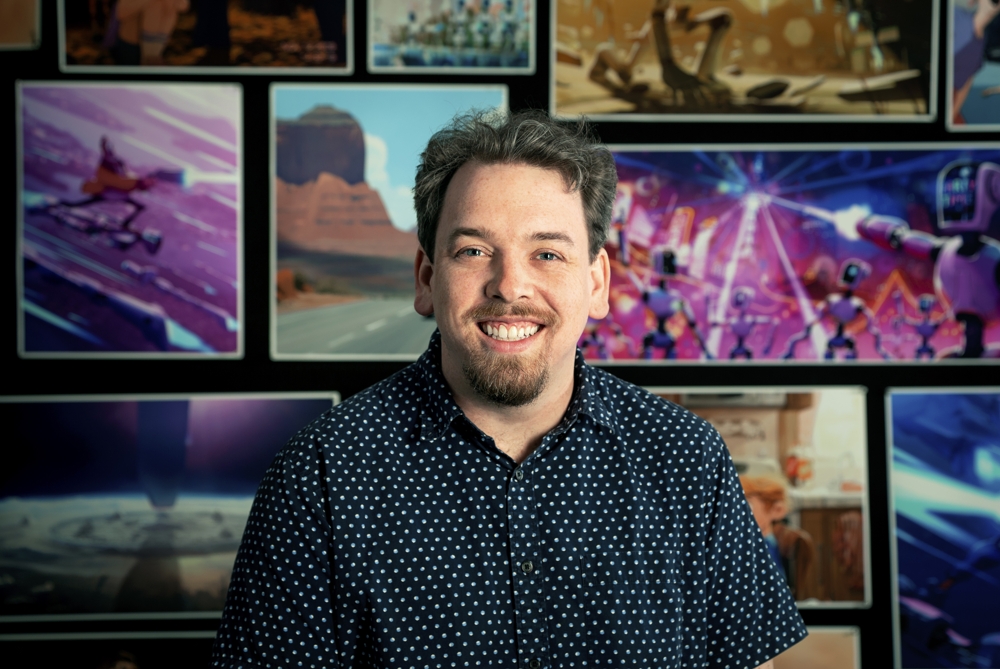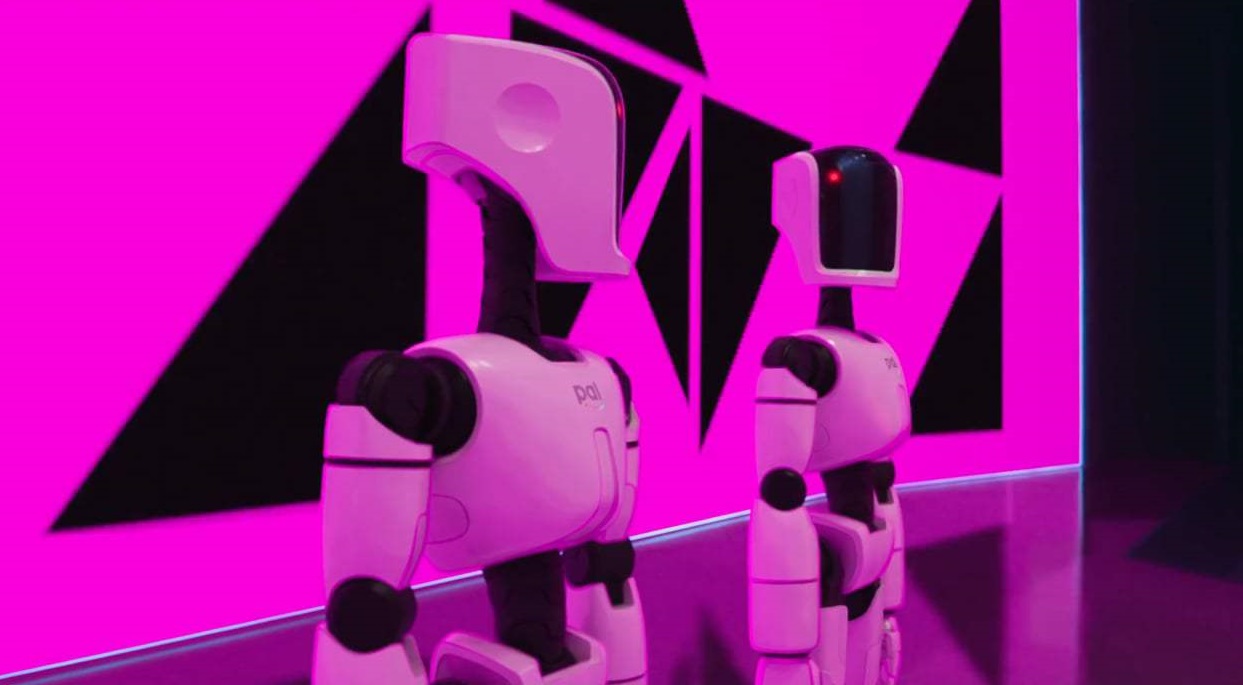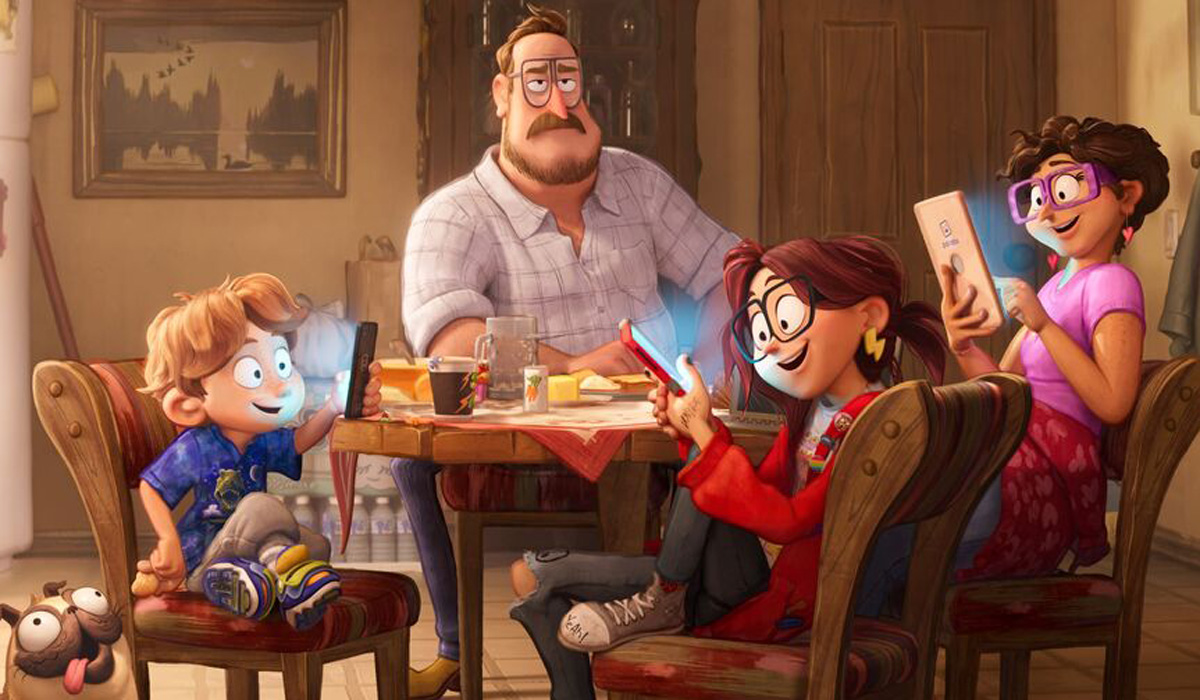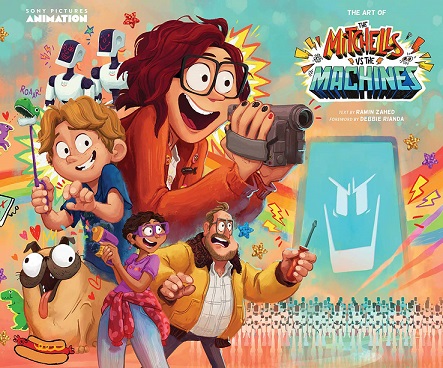 From the humans who brought you the Academy Award-winning Spider-Man: Into The Spider-Verse and The LEGO Movie comes The Mitchells vs. The Machines, an animated action-comedy about an ordinary family who find themselves in the middle of their biggest family challenge yet: saving the world from the robot apocalypse. No big deal, right? It all starts when creative outsider Katie Mitchell is accepted into the film school of her dreams and is eager to leave home and find “her people,” when her nature-loving dad insists on having the whole family drive her to school and bond during one last totally-not-awkward-or-forced road trip. But just when the trip can’t get any worse, the family suddenly finds itself in the middle of the robot uprising! Everything from smart phones, to Roombas, to evil Furbys are employed to capture every human on the planet. Now it’s up to the Mitchells, including upbeat mom Linda, quirky little brother Aaron, their squishy pug, Monchi, and two friendly, but simple-minded robots to save humanity.
From the humans who brought you the Academy Award-winning Spider-Man: Into The Spider-Verse and The LEGO Movie comes The Mitchells vs. The Machines, an animated action-comedy about an ordinary family who find themselves in the middle of their biggest family challenge yet: saving the world from the robot apocalypse. No big deal, right? It all starts when creative outsider Katie Mitchell is accepted into the film school of her dreams and is eager to leave home and find “her people,” when her nature-loving dad insists on having the whole family drive her to school and bond during one last totally-not-awkward-or-forced road trip. But just when the trip can’t get any worse, the family suddenly finds itself in the middle of the robot uprising! Everything from smart phones, to Roombas, to evil Furbys are employed to capture every human on the planet. Now it’s up to the Mitchells, including upbeat mom Linda, quirky little brother Aaron, their squishy pug, Monchi, and two friendly, but simple-minded robots to save humanity.
Produced by Oscar winners Phil Lord and Chris Miller, and Kurt Albrecht, and featuring the voices of Abbi Jacobson, Danny McBride, Maya Rudolph, Beck Bennett, Fred Armisen, Eric Andre, and Oscar winner Olivia Colman, The Mitchells vs. The Machines is about embracing the things that make us unique, learning what it means to be human in a world increasingly filled with technology, and holding tight to the people most important to you when the unexpected hits.
We were fortunate to talk about this both hilarious and emotional film with no less than its Director and Writer, Mike Rianda. Born in Salinas, California in 1984, he studied character animation at the California Institute Of The Arts from 2007 to 2010, and made the short films Everybody Dies in 90 Seconds and Work. He has since been employed by Pixar Animation Studios and JibJab, taught at CalArts, and worked at Disney Television Animation, where he served as a writer and creative director for the Annie Award-winning TV show, Gravity Falls.
Here’s our conversation with him.

Animated Views: The Mitchells vs. The Machines is built on an intriguing paradox: it’s about getting connected by being disconnected.
Mike Rianda: I think so. It is about sort of connecting with the people in your life that you love and even though that’s not always easy, it’s worth doing, it’s worth putting in the effort and building those relationships because they end up being some of the most important in your life. Also, these relationships are what separate us from machines, who can do a lot of other things that we can do already, maybe better than us. So, we tried to sort of figure out what about humanity is really valuable.
AV: It’s your first feature-length movie. Can you tell me about the challenge of working in that format?
MR: It’s the hardest thing to do! It’s brutal! But it’s also a wonderful challenge because on one hand, it’s so difficult to get one of these things working, in the sense of accomplishing the thing you’re trying to do. That’s the hardest thing. It’s just like – okay, this is a joke? We want it to be funny. This is an emotional moment? We want it to work. We want this to make people’s heart glow, you know. And it’s especially hard when it’s your first time. That’s one of the reasons why it was wonderful to have Chris Miller and Phil Lord as Executive Producers, because they were able to back us when people were like, “Hum, is that a good idea?” and we were like, “We think it is.” And then Phil Lord and Chris Miller were able to be like, “Hey, we’re with them. This is great! Let’s do it!” And then they listened to them because they made hit movies and stuff, and I’m just a guy who worked on a TV show for a while. So, it was a really wonderful experience even though it was incredibly challenging.

AV: I also loved the art direction of your movie, like a bridge between the Lizzie McGuire series, for the 2D parts, and Tron, for the technological side!
MR: Our Production Designer, Lindsey Olivares, is the first person I hired on the movie, and she was so wonderful. Ultimately, there are three parts in the movie. The first part is about humans, strange humans, and we wanted that humanity to be reflected in every frame. For instance, in our movie, trees are wobbly, they’re not these perfect CG trees you would just draw right out of the box in CG. We wanted to have every single thing in the movie to have that feel of a human hand. It’s not perfect but it’s kind of beautiful in this imperfection.
And then, there is this robots thing, and we basically came to it like – what is the exact opposite of the philosophy that we have for the rest of the movie? If this looks wobbly and weak and not perfect, we’re gonna have perfect, symmetrical, strong compositions. If we’re using earth tones, we’re gonna use crazy, bright colors, like a Mac Store, to mirror sort of the aesthetics of technology. We had tons of great artists for whom that was their specialty. We had this great Color Stylist in Dave Bleich and the Art Director Toby Wilson. They really brought some of that and made that really bold.
And finally, the “Katie vision” drawings were another way to bring humanity into the movie by showing the hand of a teenager, and it ended up making us closer to Katie as a character. It wasn’t just like an idea we tried. We tried a lot of ideas but that one really stuck because that it felt – oh, you’re getting more of the voice of the character and you’re understanding from a deeper way how this person thinks. And you’re seeing it on the screen. That was really inspiring to me and that’s one thing that I’d like to chase in future movies and stuff, you know, it’s that feeling of subjective storytelling.
AV: These 2D drawings are also the way Katie imagines her own movies. But there seems to be something more personal in there…
MR: Yes! In a way, Katie makes these movies that are a little silly but they have high aspirations. She’s an ambitious person but she’s not afraid to be goofy. That’s sort of who we are as filmmakers. We have high aspirations; we really want the movie to be of a high quality and for people to love it. But at the same time, we allow ourselves to have a lot of fun and not sort of take things too seriously.

AV: In what way do you think your experience on Gravity Falls nourished your approach to The Mitchells vs. The Machines?
MR: In many ways. I learned so many storytelling lessons from Gravity Falls. Primary, among them, is just to have characters that you love and respect as the authors. We put so much love into that show and every spec of it was picked up by people. Every little joke we had, someone noticed it and someone was excited about it. And that really was inspiring because it made you realize that the more love you put into something, the more you get to people’s hearts. So, we just tried to take that philosophy of being very generous with the audience and really rewarding their attention. And also, there’s that work ethic that we had on the series, to work hard and make sure that every scene was perfect, even if it’s harder in TV because they rip the episode away from you, before you’re like, “Oh, it’s the perfect gem!” But it’s also great because it gives you tons of experience. And then the final thing I would say is Alex Hirsch (the creator of Gravity Falls) and I were, like, we talked on the phone almost every day. He was consulting on this from the very inception of the idea. He was working on his own stuff, but I would always call him and we talked about stuff. It was awesome to have him there from the beginning. It’s no Gravity Falls movie, but hopefully all the things that I learned from it came through.
AV: How did you work with composer Mark Mothersbaugh?
MR: In many ways, this movie is some sort of fairytale that I don’t deserve (laugh). I would walk around my hometown listening to The Royal Tenenbaums soundtrack, the Rushmore soundtrack, and the Bottle Rocket soundtrack. I love Mark Mothersbaugh and I love DEVO. So, it was such an honor to work with him. He’s so inspiring. You can bring him an idea and he’ll find some instrument out of his closet that you’ve never seen before. He’s very soft-spoken but he’s so creative. We would be, like, “Can the robots be scarier?” and he’s, like, “Yeah, they can be scarier;” and he’ll find some weird instruments and find strange ways to play them. He’s really incredible. There’s like a couple emotional themes that no one else could have done. People were, like, “I’m crying in the movie and I never used to cry. What did you change about the script?”, and I’m, like, “Oh, we didn’t change anything. Mark Mothersbaugh just did the music, and it’s wonderful!”

AV: What moment in the film do you feel the most “connected” to?
MR: The scene that gets me every time is the one where Katie is seeing that her dad has sort of given up his cabin for her. That moment connects with me. When I was a teenager, I was, like, “Stop telling me how to live, Mom!!” I was such a brat! And as an adult, I’ve seen that these people clothed me, cooked food for me every night. And all those trips that my dad tried to take me on and I was so resentful of when I was a kid and that was just him trying to say ‘I love you,’ and he doesn’t know how to do it. So, that I really connect with in terms of seeing that character, like myself, learning to appreciate her parents for the first time.
AV: The end credits, with all these crew members photographed with their families, are very touching. It makes you think – as far as family is concerned, isn’t “weird” normality?
MR: (laugh) I hope so, because I do think that, since the dawn of time, everyone has always felt, like, “My family’s nuts!” And that’s one of the reasons why the movie is the way it is, because it’s, like, “My family wasn’t perfect growing up and I don’t think anybody’s is.” And I’d rather see a family like that on the screen instead of, “Good morning, Honey! Et cetera…”. – Who are these people?
I love the end credits because I love all the people who worked on the movie, and they all brought their own experiences into the movie. And I wanted to reflect that in the end credits. It isn’t just a movie made by me. It’s a movie made by me, and Jeff Rowe, my co-director, and all of these wonderful people. And if we didn’t have just one of them, the movie wouldn’t be what it is.
With our thanks to Mike Rianda and Fumi Kitahara.




